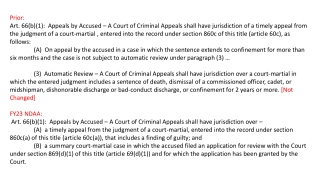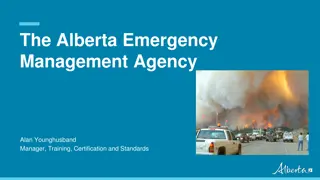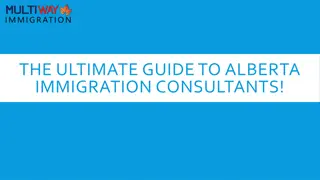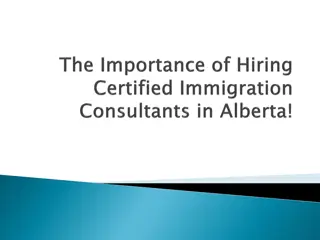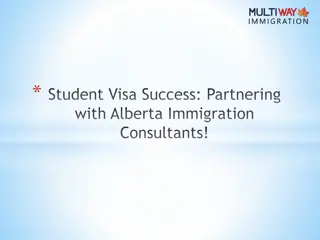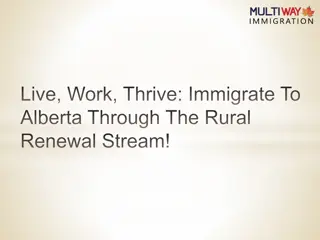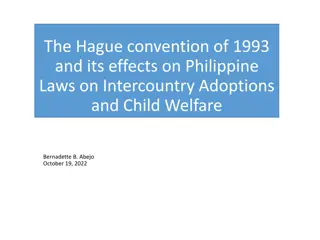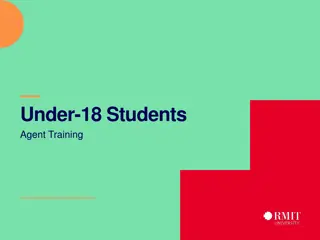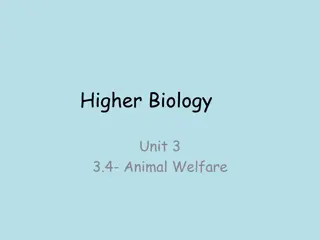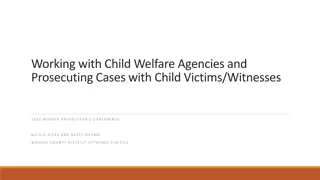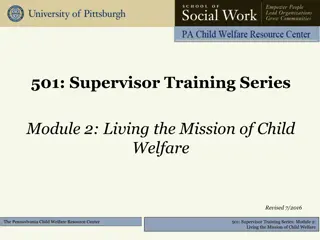Understanding Court Processes and Child Welfare Laws in Alberta, Canada
In this presentation, Tracey Snow, Justice and Attorney General, aims to enhance the knowledge and skills of agency workers in court processes. The content covers the roles of court personnel, the Rule of Law process, and key acts such as CYFEA, PSECA, and DECA. It also discusses the intervention criteria under CYFEA and the definition of a child in need. This informative session provides valuable insights into legal frameworks and procedures concerning child welfare in Alberta, Canada.
Download Presentation

Please find below an Image/Link to download the presentation.
The content on the website is provided AS IS for your information and personal use only. It may not be sold, licensed, or shared on other websites without obtaining consent from the author. Download presentation by click this link. If you encounter any issues during the download, it is possible that the publisher has removed the file from their server.
E N D
Presentation Transcript
To increase the knowledge and skill level of Agency workers of court processes (understanding roles, preparing for and testifying) To ensure Agency and CFSA workers have a common understanding of their roles and expectations in: preparing for and providing evidence in court
Rule of Law Process by which law is enacted Courts in Alberta/Canada Roles of court personnel judge, reporter, lawyers, witnesses Courtroom setup
Child, Youth and Family Enhancement Act (CYFEA) Protection of Sexually Exploited Children Act (PSECA) Drug-endangered Children s Act (DECA) Protection of Children Abusing Drugs Act (PChAD) Protection Against Family Violence Act (PAFVA) Alberta Adult Interdependent Relationship Act (AAIRA) Family Law Act (FLA) Family Support for Children with Disabilities Act (FSCDA) School Act Freedom of Information and Protection of Privacy (FOIP) Act Indian Act Mental Health Act Health and Wellness Legislation Secure Services Process
From Section intervention if there are reasonable and probable grounds to believe that the survival, security or development of the child is endangered because of any of the following: (a) the child has been abandoned or lost; (b) the guardian of the child is dead and the child has no other guardian; (c) the child is neglected by the guardian; (d) the child has been or there is substantial risk that the child will be physically injured or sexually abused by the guardian of the child; (e) the guardian of the child is unable or unwilling to protect the child from physical injury or sexual abuse; (f) the child has been emotionally injured by the guardian of the child; (g) the guardian of the child is unable or unwilling to protect the child from emotional injury; (h) the guardian of the child has subjected the child to or is unable or unwilling to protect the child from cruel and unusual treatment or punishment. From Section 1of the of the CYFEA CYFEA (2) (2) For the purposes of this act, a child is in need of
Orders Supervision Order Temporary Guardianship Order Permanent Guardianship Order Adoption Mediation Processes Judicial Dispute Resolution (JDR) Alternate Dispute Resolution (ADR) Peacemaking Circles Family Group conferencing (FGC) Role of family/extended family and community
Identifying sources Behaviour reporting/recording Facts vs. assumptions/opinions Considerations Contact notes guidelines Mindfulness, amount of detail Consents, release of information Other notes datebooks etc.
Court report is written Consultations with supervisor have occurred Applications are filed in court Contact with office s legal counsel made Child s file is vetted for disclosure through Caseworker s counsel Client s file is reviewed and a tentative witness list compiled for counsel With counsel, an estimate of the number of days a trial will be made
Agency worker It is not necessarily the role of the Agency worker to validate the caseworker s opinion Prepare and present information as to the child and family s functioning No surprises in relation to family, caseworker Honesty and clarity Lawyers representing ministry/family/child Other witnesses/family
There are two formal processes to support finding resolution of contested applications without the need for a trial. Mediation services provide the parties an opportunity to hear each other out with a neutral mediator. Judicial Dispute Resolutions (JDR) are a court process where a judge hears all the information and then notes what he or she would grant if at trial.
Read the subpoena It contains important information, including the name of the case in which you are to give evidence, which court you are to appear in, the courtroom number and the time the proceeding is to start. If the courtroom number is not shown or if you do not know the exact location of the courthouse you should check in advance, with the assigned caseworker or casework supervisor.
Yes. If you do not appear as ordered, the court may issue a warrant for your arrest. Yes. A Subpoena takes precedence over nearly every other duty. Your employer cannot prevent you from appearing in court.
The lawyer calling you as a witness may wish to interview you before your appearance in court. This is done to review the strength and accuracy of your testimony.
Review all submitted monthly reports, case conference notes and daily contact logs on the client file. Review and identify areas of concern as outlined in the reports. Compare your reports to the daily logs to ensure you are able to report further details regarding client actions/interactions. Be prepared to give details on your observations. The lawyer or assigned caseworker will arrange a time to meet to discuss your testimony within a month prior to the trial dates.
Bring any relevant information as agreed upon in the witness interview. Dress in a professional manner. Report to the court room/caseworker upon arrival. If court is in session wait outside the court room until you are called.
You will be called to the court room by the lawyer or caseworker when it s your turn. Bring only relevant documentation into the court room. Use proper courtroom etiquette. Ensure all cell phones are off; do not have it on vibrate. Do not chew gum or bring beverages into the court room; water is provided for the witness. Be prepared to stand during your testimony. Let legal counsel know if you have a medical condition that may prevent this prior to entering the court room. The court clerk will take your oath; you can swear or affirm. Speak clearly and loud enough to be heard.
Admissible information Exclusionary information and exceptions Character Hearsay Opinion Written documents notes, files, datebooks etc. Oral testimony Maintaining relationship with family
Answer all questions asked by the Directors counsel to the best of your ability. Once Director s counsel is done the Respondent's counsel will be next. Parent s lawyers and if applicable the child s lawyer will be last. Director s counsel has the ability to ask further questions, once all counsel have completed their direct examination, which is called redirect . In some cases, the judge may also have questions and can directly ask the witness.
Answer all questions honestly and with clarity. Answer only the question asked; do not elaborate unnecessarily. State facts, not opinions/assumptions. NEVER BE AFRAID TO ASK IF YOU DON T UNDERSTAND A QUESTION OR NEED THE QUESTION REPEATED.
Alberta Human Services, Enhancement Policy Manual: Intervention (Revised June 15/12) http://www.child.alberta.ca/home/docume nts/childintervention/Enhancement_Act_Poli cy_Manual.pdf Alberta Courts Information http://search.albertacourts.ca/ or http://justice.alberta.ca/Pages/home.aspx Alberta Justice, Family Justice Services Mediation/Dispute Resolution Processes http://www.albertacourts.ab.ca/fjs/adr.php
Presenter: Tracey Snow, Solicitor Justice and Attorney General Tracey.Snow@gov.ab.ca Tel: 780-415-1878


